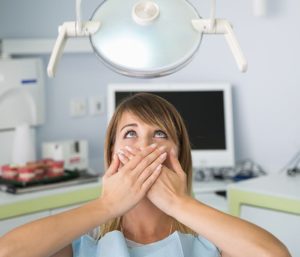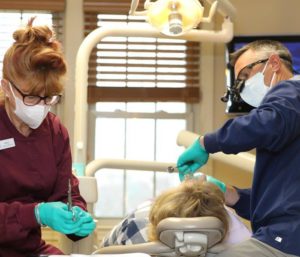ARE YOU A FREAK OF NATURE?
September 26, 2022
 I attended a continuing education course a while back entitled “Hit Man or Healer?” The course was given by a well-known leader in the dental profession. The basic premise of the course was the notion that we have a lot more science, studies and data available today to be able to make better decisions about the treatment that we dentists recommend to patients. The concept is called evidence-based dentistry.
I attended a continuing education course a while back entitled “Hit Man or Healer?” The course was given by a well-known leader in the dental profession. The basic premise of the course was the notion that we have a lot more science, studies and data available today to be able to make better decisions about the treatment that we dentists recommend to patients. The concept is called evidence-based dentistry.
The idea is that if a very structured examination and diagnosis is done, treatment recommendations can be made based on science. The problem is, all too often the diagnosis leads to suggestions that without the proper dialogue can make the dentist look like a “hit man” (ie. patient perception of over-treatment) vs. “healer” (intervention with the intention to preserve the teeth better for the long-term).
The lecturer started by putting an image of a person’s teeth on the screen and asking the audience to guess how old the person was. My father and brother are veterinarians. They use the appearance of teeth to estimate an animal’s age. Although it is relatively easy to estimate a person’s age during transition from the primary teeth to permanent teeth, it is apparently a little more difficult when all the permanent teeth are in. I guessed the age of the patient on the screen to be between 50 and 60.
The patient had great looking teeth. You could tell the person was a mature adult by the darkening of the teeth, but there was very little wear and very minimal dentistry. The patient ended up being 94 years old, which was more evident when her full face was projected on the screen…..although she looked great in general for 94. The lecturer said, “Is this the way teeth should look at 94 or is this woman a freak of nature?”
While there are definitely genetic factors that may play a role, many of the problems we see today with teeth are 100% preventable. For example, dental decay is 100% preventable. However, it is still not uncommon today to have a patient (maybe a teenager or an older person on multiple medications with dry mouth) come in for a routine dental hygiene appointment and be told they have decay, or multiple areas of decay, which were not present 6 months ago. In that scenario the dentist would be considered the “hit man”.
The “healer” may have taken a different approach, and may have done a more thorough evidence-based evaluation and made recommendations based on diet, homecare habits and maybe even familial history that could prevent the decay in the first place. Dentists have gotten good at telling patients how they can “fix” the problem, but need to consider changing their thinking and get more training in how to “prevent” the problems we see today in dentistry.
Many of the basic principles learned in dental school are used on a routine basis. However, there is continuous new data emerging that we as health care providers need to expose ourselves to and decide on what and how to implement for the benefit of our patients. I hope to see major advancements in our approach to oral health care in my career. There is no reason you can’t live to 94 and have a great set of teeth.
As I have said numerous times over the last few weeks, and you will hear it again next week too: Unfailing routine professional maintenance is a key factor in achieving and maintaining dental health. Don’t just hope you’re a freak of nature.
Dr. St. Clair maintains a private dental practice in Rowley and Newburyport dedicated to health-centered family dentistry. He has a special interest in treating sleep apnea and TMJ problems. If there are certain topics you would like to see written about or questions you have please email them to him at jpstclair@stclairdmd.com
5 REASONS PEOPLE AVOID THE DENTIST
September 19, 2022
 There are five major reasons that people do not get the necessary dental care they need; six if you count the recent pandemic. The other five are money, time, lack of concern, fear and trust. Let’s take a quick look at each one and see if any of them fit you, and what dentists often try to do to overcome these obstacles for patients.
There are five major reasons that people do not get the necessary dental care they need; six if you count the recent pandemic. The other five are money, time, lack of concern, fear and trust. Let’s take a quick look at each one and see if any of them fit you, and what dentists often try to do to overcome these obstacles for patients.
Although you may think that money would be the number one reason people avoid ideal dental treatment, it is not. Even in tougher economic times, money, although a significant barrier for many, is still not the number one issue for most. Dental health, and good health in general, always requires some kind of investment.
Lack of dental insurance is a poor excuse for not getting regular dental maintenance. As I have said numerous times, dental insurance in not insurance; it is a benefit. If it were “insurance”, it would cover treatment that patients need. While not bad to have, the advantage is limited, based on insurance company’s unwillingness to raise the bar and change a system that hasn’t changed since the 1970’s.
Unfortunately, as of now, we have to face these facts, and it does not mean avoiding the dentist. Many dentists offer in-office payment plans, as well as plans through third party carriers, so patients can finance needed treatment. Two dental hygiene appointments a year costs way less than many other things people spend money on. If you drive your car for 20,000 miles without maintenance, something is bound to happen. The better you take care of your car, the less problems you’ll have.
Time is another excuse. We all use time as an excuse for many of the things in our lives we want to avoid or procrastinate on. The reality is, however, if we place something high enough in our value system, there is always time for it. In order to move something higher up in our value system, we must be enlightened enough to realize that this particular thing is of benefit to us. This brings me to the most common reason people avoid ideal dental care.
Lack of concern about dental health is prevalent with a large percentage of the population. Absence of pain is the biggest reason for this lack of concern. Other than a severe toothache and need for a root canal or extraction, there are few things that cause enough pain to bring someone to the dental office. Take gum disease; about 75% of the population has some form of this disease, but only 50% of the population goes to the dentist. Why? No pain. Absence of pain is a poor indicator of health.
Some people have fear about going to the dentist….and for good reason, due to bad past experiences or bad information. However, dentistry today should be a comfortable experience most of the time. For those that are still fearful, there are different medications dentists can use to ease the experience.
The last barrier to ideal treatment is trust. For a patient to move forward with treatment, it is essential the patient both like and trust the dentist. Although I am sure that the skills of your dentist are important to you, I am willing to bet that you would not stay with a dentist who you did not like or trust. Find someone you can connect with and build a strong doctor-patient relationship.
I believe that one of the best things a patient can do for their dental health is to find an office they like and trust……and stay there. Continuity of care is in the patient’s best interest. Find your dental home.
Dr. St. Clair maintains a private dental practice in Rowley and Newburyport dedicated to health-centered family dentistry. He has a special interest in treating sleep apnea and TMJ problems. If there are certain topics you would like to see written about or questions you have please email them to him at jpstclair@stclairdmd.com
BACK TO THE BASICS
September 12, 2022
 Every once in a while, someone will say, “There must be a lot less cavities today than there were years ago because of improved home care, fluoride, etc., right?” Maybe in general, but there is still way too much decay. Poor diet and home care are the two most common culprits leading to decay. Dentists have seen a significant increase in decay during COVID. When and what you eat and drink is important. Improvement in home care means changing what is being done now, and requires discipline.
Every once in a while, someone will say, “There must be a lot less cavities today than there were years ago because of improved home care, fluoride, etc., right?” Maybe in general, but there is still way too much decay. Poor diet and home care are the two most common culprits leading to decay. Dentists have seen a significant increase in decay during COVID. When and what you eat and drink is important. Improvement in home care means changing what is being done now, and requires discipline.
Yesterday, I went into one of my hygienist’s rooms to check her patient, a 13-year-old boy, and asked the hygienist how his home care was, because his gums were bright red. She said to me, “Jack, why don’t you tell the doctor how often you told me you brush your teeth.” The boy answered, “About once a week.” ONCE A WEEK?!?! Add the fact that he is in braces, which makes it even more important to keep the teeth clean.
It’s important sometimes to step back and review the basics, so here they are. At a minimum, you should brush with a fluoride toothpaste at least twice a day for two minutes. A good electric toothbrush is preferable to a manual toothbrush. When I say “good”, I mean one that sits on a charger, and not one that takes AA batteries. There are two major brands out there. I prefer the one that starts with an “O”.
It amazes me how many people don’t floss their teeth. I have heard every excuse in the book; “My fingers are too big”, “I don’t have the time”, “It’s too hard”, “My dog ate the floss”. Just like anything else, it is always hard to start a new ritual. There are so many different kinds of floss and gadgets to help floss that there is something out there for everyone. And if you can’t seem to make it work, use a water pik; it works better than floss anyway.
Bacteria, which accumulates on and between the teeth, forms that white film called plaque. Plaque contains billions of colonized bacteria. The right kind of bacteria, along with the wrong king of diet and the wrong genetics can produce cavities. Plaque that is not removed with thorough daily brushing and flossing can harden and turn into calculus (tartar). These colonized bacteria can then lead to tissue inflammation (gingivitis), the early stage of periodontal (gum) disease.
Brushing your teeth helps get rid of most of the plaque, except for the stuff that accumulates between the teeth. That is what floss and the water pik are for. I know it sounds gross but if you want to know what your breath smells like, floss a few teeth and then smell the floss. That should turn you into an avid flosser.
The routine should be, floss (water pik), brush, rinse. The whole event should be around five minutes. Believe me, you have five minutes. Cleaning between the teeth first allows the fluoride from the toothpaste to contact a cleaner tooth surface between the teeth. I prefer a non-alcohol-based rinse, as alcohol is drying and creates a better environment for bacteria to thrive.
If you do choose floss, technique is important. Proper flossing is not popping the floss between the teeth and shooting it right back up. The proper way to floss is to get the floss between the contact of the teeth, slide the floss gently under the gum tissue around one tooth, “shoe-shine” the side of the tooth, gently move the floss over the papilla (the little piece of gum between the teeth), “shoe-shine“ the side of the other tooth and then bring the floss up. At your next dental visit, ask your hygienist to evaluate your flossing skills to make sure you are doing it correctly.
You have the 5 minutes twice a day.
Dr. St. Clair maintains a private dental practice in Rowley and Newburyport dedicated to health-centered family dentistry. He has a special interest in treating snoring, sleep apnea and TMJ problems. If there are certain topics you would like to see written about or questions you have, please email them to him at jpstclair@stclairdmd.com
THE DENTAL EXAM
September 6, 2022
 Diagnosis is the key to success in any area of medicine, including dentistry. Proper diagnosis leads to success in treatment. In dentistry, there are different exams used at different times of a patient’s “career” at the dental office. I would like to clarify some of these in this column.
Diagnosis is the key to success in any area of medicine, including dentistry. Proper diagnosis leads to success in treatment. In dentistry, there are different exams used at different times of a patient’s “career” at the dental office. I would like to clarify some of these in this column.
The Comprehensive Oral Evaluation is the term used to describe the initial exam with a new dentist. This evaluation usually is a more detailed exam performed by the dentist. It includes charting of the patient’s teeth (including present/missing teeth and existing restorations), a periodontal exam (to determine the health of the gums and bone that support the teeth), a visual oral cancer screening (a detailed exam of the soft tissues to check for any abnormalities), a review of the patient’s health history (including familial history, medications, etc.), and a general occlusal exam (an evaluation of how the teeth, muscles and TMJ joints are working together). This exam is used as the baseline for where a patient starts in an individual dental practice.
Dentists may spend 60-90 minutes with a patient to do this initial exam. In dental offices that have a particular focus on whole body wellness, this may also include salivary testing, a deep dive into WHY things are happening that should not be happening, a sleep breathing disorder screening, and communication with other health care providers to provide comprehensive care.
The Periodic Oral Evaluation is the exam that is done in conjunction with visits to the hygienist. It is separate from the “cleaning” of the teeth. This exam generally looks at the same areas as the previous exam described, but in less detail. The results of this exam are compared to the baseline exam that has been previously completed. Although the exam must be overseen by a dentist, many of the parts of the exam may be performed by the hygienist and reviewed by the dentist.
The Limited Oral Evaluation is the term used to describe an unscheduled visit to the dentist, usually for when a patient presents with a problem. For example, if a patient presents with the chief complaint of a toothache, this exam covers the reading of any necessary dental x-rays and diagnosis of the problem. It may result in the scheduling of the patient for treatment, or referral to a specialist.
There is also the underutilized Occlusal Analysis. It is often done as part of the comprehensive exam, however some patients who have certain “bite” issues, need a more focused evaluation of this area. This exam serves a very distinct and important role in the diagnosis of many issues that patients encounter, which can lead to much greater success in treating these patients.
Temporomandibular joint (TMJ) issues, muscular problems, tooth wear/fracture and pre-prosthetic evaluation are all things that could benefit from the occlusal analysis. It is generally a combination of a clinical exam and an evaluation of models of a patient’s teeth, which are mounted on an instrument which simulates the patient’s jaw movements. This is often done digitally with scanning and software now.
Ideal is a Comprehensive Oral Evaluation for each new dentist you see in your lifetime (the fewer the better), a Periodic Oral evaluation every 6 months or one year depending on your needs, and to never need a Limited Oral Evaluation because you are a stellar dental patient who is being managed by a conscientious dental team.
Dr. St. Clair maintains a private dental practice in Rowley and Newburyport dedicated to health-centered family dentistry. He has a special interest in treating snoring, sleep apnea and TMJ problems. If there are certain topics you would like to see written about or questions you have, please email them to him at jpstclair@stclairdmd.com







